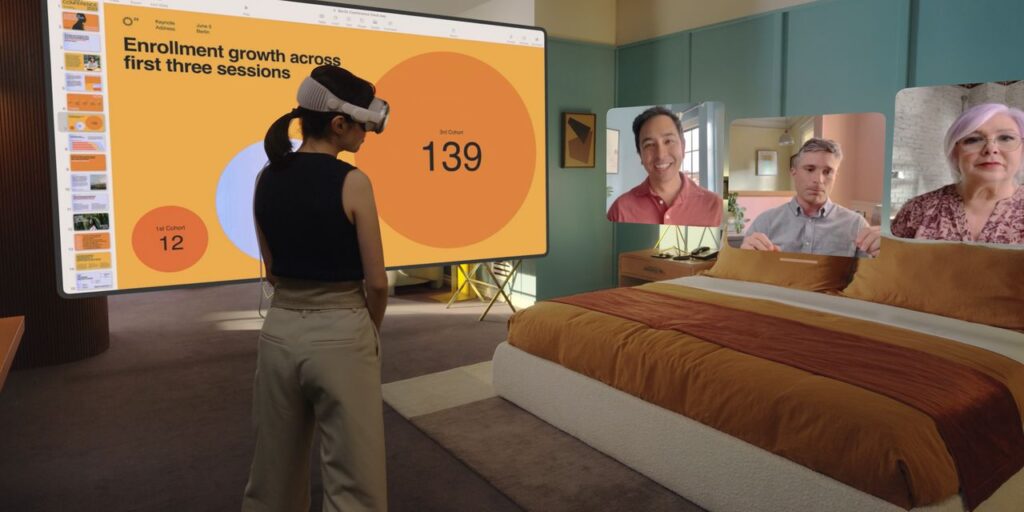Tech “visionaries” have been attempting to sell the world on a virtual-reality future for decades, largely using videogames and overwrought hype as a hook, but Apple Inc. took a more grown-up — and exciting — approach on Monday.
When Apple
AAPL,
finally showed off its much-anticipated augmented-reality headset, executives avoided the hype and the hypermasculine imagery that has long been associated with a technology that has never moved beyond niche. It was a welcome approach, and portends a potentially strong offering — though the wait for proof of that potential will be long.
“ ‘Vision Pro will introduce us to visual computing.’”
Apple’s device looked to represent a vast improvement to the concept of effectively moving a computer to the user’s face, a step up from the Quest virtual-reality headsets by Meta Platforms Inc.
META,
and from the early iteration of the abilities of Google Glass a decade ago. Apple showcased the headset in many different uses, from the office environment, where it could be used for 3-D rendering and models of structures, to the home, where a woman immersed herself into meditative spaces and entertainment, going on to interact with friends in an augmented version of FaceTime.
“In the same way that Mac introduced us to personal computing and iPhone introduced us to mobile computing, Vision Pro will introduce us to visual computing,” Apple Chief Executive Tim Cook said.
Read: We’ve been promised the metaverse for decades, but it’s still not a sure thing
The Vision Pro device itself seemed impressive. Mike Rockwell, Apple’s vice president of augmented and virtual reality, said during a keynote address at WWDC that Apple had filed 5,000 patent applications during the multiyear development of the device. “We have been building for this moment for years,” he said.
Apple is clearly betting that the Vision Pro is going to deliver an iPhone moment for mixed-reality devices, and for a new generation of computing. It was easy to see how the Vision Pro could be used by architects, engineers, product manufacturers and even passengers on an airplane who want to tune out their surroundings.
The concept of using Vision Pro for work provided valuable imagery because Apple’s $3,500 price tag is obviously not calibrated toward hobbyists and gamers. That price tag and the capabilities displayed Monday call to mind high-end professionals willing to pay for the experience — or, at least as likely, have their employers pay for it.
For more: Is it worth spending $3,499 on Apple’s Vision Pro VR headset? Read this first.
Many others who have played around with mixed reality — including Microsoft Corp.
MSFT,
— have pitched such devices with an eye on the consumer market, but eventually found greater acceptance from the corporate market. Apple seems to have absorbed that lesson before launch and will be marketing its device not as a fun toy but as a replacement for an expensive Mac or other personal computer — a replacement that could offer plenty of new experiences.
“ ‘We have been building for this moment for years.’ ”
The multiple virtual screens and the motions of a user’s hands manipulating them, as well as super-high-resolution images of 3-D films and spatial audio, stood in contrast to the childish images that we have largely seen of Mark Zuckerberg’s vision for a “metaverse.” There were no cartoon avatars — missing legs or otherwise — in Apple’s demo Monday (nor was a keyboard, even a virtual one, or any kind of controller, to be seen).
See: Will Apple headset provide lifeline for Mark Zuckerberg’s metaverse or kill it?
This was just a taped demonstration, however, with no proof that the experiences shown would be as easy and enjoyable as executives promised. And there will be quite a wait to find out how close the actual experience is to the marketing for most of us: Apple will not launch the Vision Pro until 2024, missing out on this year’s holiday shopping season. That delay likely contributed to Wall Street’s muted reaction to the event, with shares falling from all-time highs early in the session to a daily decline.
The wait for the first Vision Pro to land in users’ hands — and on user faces — is not the only holdup in store. Sales are expected to be slow at first, with Apple’s initial price of $3,499 putting this device out of reach for most. and developers could take years to jump on board and create applications to take advantage of the new headset and its augmented world.
“Given the high price points, we believe initial shipments are expected to be roughly 150,000 units for Year 1 and roughly a one million units in Year 2 at lower price points,” Wedbush Securities analyst Dan Ives wrote.
So it will take time to learn whether Apple’s costly Vision Pro is the biggest hit yet for Tim Cook, who has spent nearly 12 years at the helm of Apple but so far has not delivered a new product to rival the successes of his predecessor, the legendary Apple co-founder Steve Jobs.
What Apple showed Monday is a device that could be as game-changing and groundbreaking as the iPhone, but the journey to proof of that concept is going to be arduous.
Read the full article here













